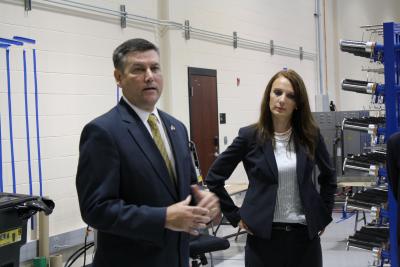NASA Officials Visit Spotlights Partnership with Southern Miss
Wed, 06/22/2011 - 11:53am | By: Van Arnold

Recent grants provided by NASA to The University of Southern Mississippi have not only enhanced research efforts but also helped strengthen the partnership between the space agency and the university.
On Wednesday, June 22, officials from NASA's John C. Stennis Space Center spent time in Hattiesburg, Miss., to get a first-hand look at how the grant money is being used. Led by Stennis Center Director Patrick Scheuermann, the group toured the Accelerator, Southern Miss' unique business incubator, as well as the university's National Center for Spectator Sports Safety and Security (NCS4).
“NASA is proud to partner with The University of Southern Mississippi on these efforts that have such tangible and important impacts,” said Scheuermann. “These projects demonstrate how partnerships such as this one can produce important technological innovations that benefit society.”
Bryan Brister, director of the Mississippi Polymer Institute (MPI) housed within The Accelerator, noted that $1 million in NASA grant money helped outfit the facility with state-of-the-art research technology. MPI pioneered rapid prototyping in the 1990s. Thanks to the grant funding, the institute managed to leapfrog its prototyping capability by purchasing top-flight equipment for non-destructive laser scanning and 3D printing.
“One of the assets we were able to acquire is so advanced that we are among only three universities in the entire country to possess it,” said Brister.
Brister notes that the close relationship with NASA yields significant payoffs such as allowing MPI to bring cutting-edge technologies to bear on behalf of Mississippi-based companies.
“Impacted businesses range from those producing materials to those performing design and engineering work,” he said. “In any economic climate, this university strives to provide a tremendous return on invested dollars from partners like NASA. Their visit today is an opportunity to show just how effectively we are utilizing the resources provided.”
Officially labeled the National Materials Science Innovation and Commercialization Accelerator, the 60,000-square foot incubator held its grand opening last September. The facility provides extensive space for offices, laboratories and storage; the latest advances in technology and expert guidance for companies attempting to grow a business from the ground up.
“If we, as citizens in our nation's great recession want to aim toward positive and sustainable economic growth, we have to invest in new technology,” said Sunny Webb, executive director of The Accelerator. “This strategic partnership between NASA and Southern Miss will positively influence the creation of technology-based jobs. These jobs will offer students the opportunity to stay in our region post-graduation and offer competitive and higher-paying opportunities for our existing workforce.”
A $75,000 grant provided by NASA enabled NCS4 officials to secure a new multi-touch, multi-user surface computer. Developed by NVision, the computer runs the REACT/SportEvac software being used by NCS4 in designing and conducting table-top training exercises for both professional and collegiate venues.
NCS4 Director Dr. Lou Marciani said the grant gives the center “a chance to enhance our training capabilities by involving the incident command team in the what-if scenario management, planning and training sessions.”
But he is quick to point out that the grant extension also represents a perfect illustration of the important alliance that exists between Southern Miss and NASA.
“For more than 50 years, NASA has been at the forefront of exploration and innovation in our country,” said Marciani. “At NCS4 it is our intention to explore ways in which we can assist NASA with their emergency management training efforts.”